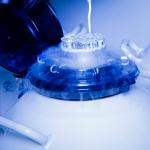Inside a Spanish fertility clinic
As one specialist calls for children to be educated on fertility, Healthista brings you a fertility special, kicking off with this video giving us an exclusive look inside the IVI fertility clinic in Madrid where 300 British patients are treated for fertility problems each year
At the IVI clinic in Madrid, the exterior looks like any other building. But human life is made in a lab there every day through pioneering fertility treatments.
Nearly 50,000 British women a year have IVF. But many, frustrated with the postcode lottery that exists for treatment on the NHS are now flocking to clinics like this one.
Many UK women come to Spain
for anonymous egg donation
‘Most UK couples and UK women, mainly come here for egg donations,’ said Dr Juan Antonio Garcia Velasco, Medical Director of IVI Madrid.
‘Of course, some of them come for PGD [Pre-implantation Genetic Diagnosis] or egg freezing or other different things, but mainly they come for egg donation and here anonymity is a big issue.’
Dr Velasco said he finds it interesting that there are women in Spain who want to have an open donation and they go to the UK to get treatment, and on the other hand, UK women travel to Spain because they want to have an anonymous donation.
In the UK, the children of sperm and egg donors can find out their donor’s identity when they turn 18, which has led to waiting lists of up to six months. But in Spain, they’re anonymous and sperm and egg donors are readily available and can even be matched to a couple’s ethnicity and colouring.
we try to find the best match based on patients’ ethnicity, hair colour, hair type, eye colour, skin type, more or less height and weight
‘In Spain it’s based on the patient’s physical characteristics â€" this is what Spanish law tells us to do,’ said Dr Erick Hauzman, Specialist in Reproductive Medicine at IVI Madrid. ‘This means that we try to find the best match based on patients’ ethnicity, hair colour, hair type, eye colour, skin type, more or less height and weight.
‘But patients need to accept that this is somewhat different from, for example, what is practised in the United States when you can choose personally from catalogs.’
Flash-freezing eggs help maintain
quality for longer periods
IVI runs 17 clinics across Spain and their work has led to a number of landmark fertility breakthroughs.
In 2007, IVI scientists in Spain were the first to introduce a groundbreaking method of egg-freezing called vitrification or ‘flash-freezing’.
This maintains the quality of women’s eggs far better than previous methods.
‘The survival rate which used to be 60 or 70 per cent became 95 per cent, and the success rate is exactly as it is with fresh oocytes (eggs) or with fresh embryos, so this has completely changed the way we practised,’ said Dr Velasco.
More recently, IVI scientsts â€" in conjunction with a team in Denmark â€" developed an incubation system that captures an embryo’s moment-by-moment growth.
IVI scientists developed a system that captures an embryo’s moment-by-moment growth
‘Instead of taking the embryo [out of a regular incubator] and checking it under the microscope, ]which exposes it to the elements], you can the embryo’s development every ten minutes, and it’s development on time lapse motion the next morning,’ Dr Velasco said. This all happens without the embryologist ever having to take the embryo out of the incubator, thus increasing its chances of surviving healthily.
‘When you aren’t looking at the embryo sometimes they do wrong things, and if you don’t see it you think everything’s fine. But when you can check it’s growth and you can control for that, you can then select the best embryo with the highest implantation potential.’
To find out more about IVF and other reproductive techniques and treatments of the IVI Clinic in Madrid click here.
Read Healthista Editor Anna Magee’s report into the fertility industry in the Sunday Telegraph’s Stella magazine



0 comments:
Post a Comment